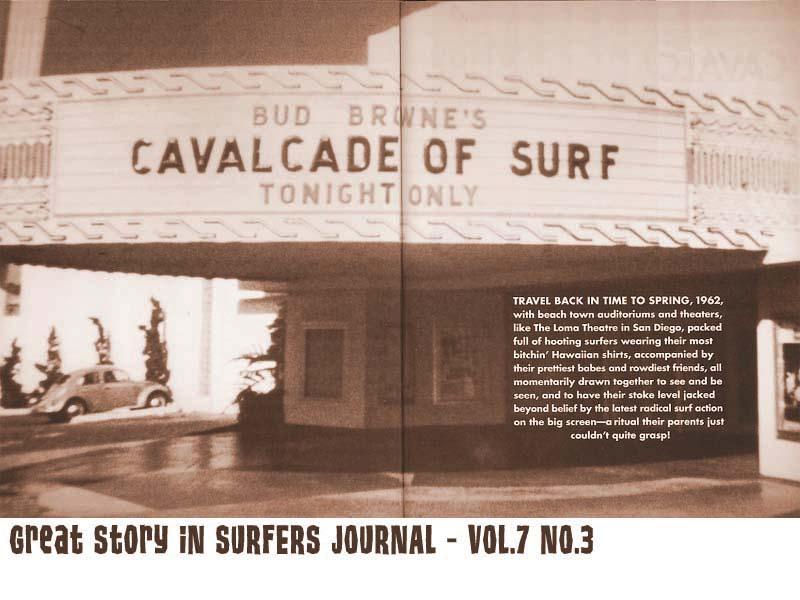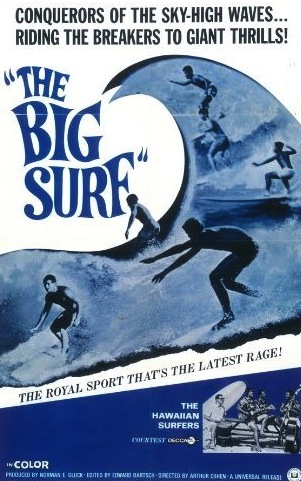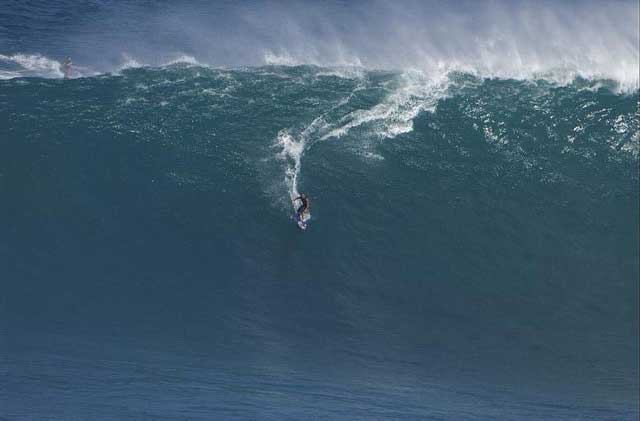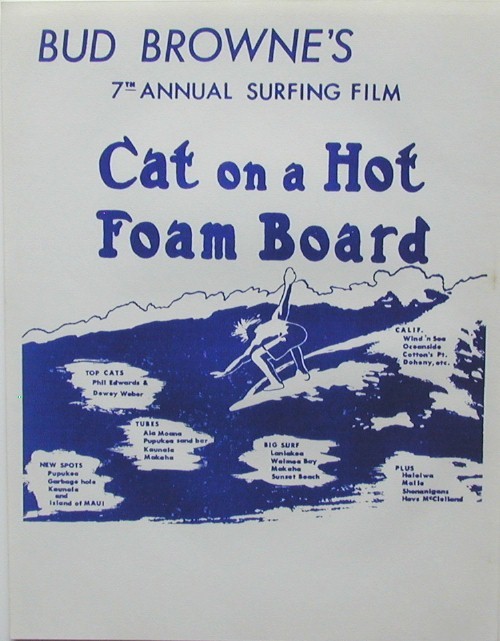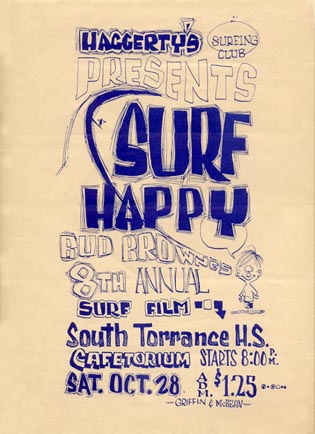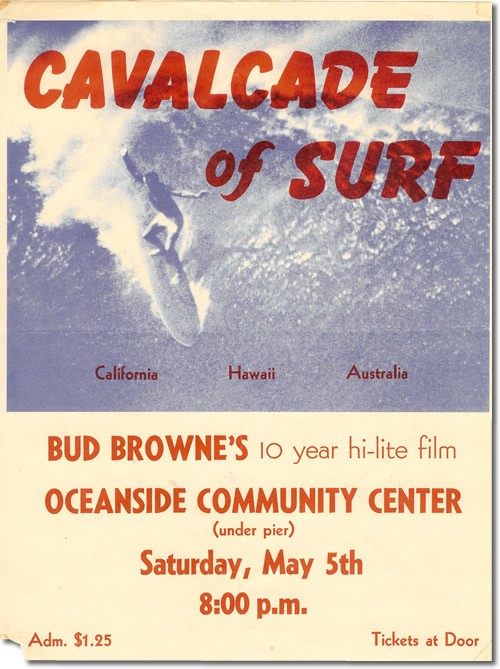‘Bud Created The Genre of Surf Films’
Remembering Bud ‘Barracuda’ Brown
In the beginning, there were no surf magazines. There were no VCRs, and there sure as hell was no Internet. Between the growing pools of surfers worldwide, there was no communication, period. If someone were to pull a cutback, it would be years before rumors would trickle around the globe, and by then it would be embellished into a rodeo flip. In 1953, a teacher from Los Angeles delivered surf movies to the world and changed everything. From the Duke to Lopez, Bud Browne recorded it all, chronicling our little sport and inspiring legions of followers.
Browne was born in Newtonville, Massachusetts, on the outskirts of Boston. He began swimming competitively at age seven, also partaking in basketball, tennis and track and field. After moving around the country with his family for much of his young life, he settled in California in 1931 to attend University of Southern California, where he was the captain of the swim team (ranked second in the nation) and swam competitively on behalf of the L.A. Athletic Club until 1948. Work as an L.A. County lifeguard led to an interest in diving and surfing, which he witnessed for the first time in 1932 at Corona del Mar. On a rescue board, he began surfing in 1938 at Sunset Pier. The same year, he went to Hawaii where he rode Waikiki and later filmed Duke Kahanamoku. During World War II, Browne served as a navy chief specialist in athletics (and earned the nickname "Barracuda" for his elongated figure and extreme amount of time spent in the water). Afterward, he became a member of the Waikiki Surf Club, started teaching in the Los Angeles Unified School District and bought a 16mm Bell and Howell movie camera.
He soon learned about editing at the USC cinema school, and in 1953, a fellow teacher invited him to show his footage at Adams Junior High in Santa Monica. Bud called his work Hawaiian Surfing Movie, hung handmade signs on telephone poles and charged a 65-cent admission. The surf movie was born. Browne left teaching and made one movie annually for the next 12 years, filming around the world, then showing the spoils to stoked masses in school gymnasiums. At first, the films were accompanied by live narration, and in 1961, he began attaching soundtracks, helping to popularize the "surf" sound made famous by Dick Dale. Humor, in the form of skits performed by the surfers themselves, gave them a lighthearted feel. In addition to nearly 20 of his own films, he also contributed footage to the team of MacGillivray/Freeman in Waves of Change (now The Sunshine Sea) and Five Summer Stories.
Browne's movies, followed by those of others, became the primary form of communication among early surf culture. They inspired kids to become surfers and turned surfers into stars. Hawaii was an unknown entity in Australia until Browne filmed first Makaha, then the North Shore in 1957. Later that year, his footage was packaged into two films, Surfing in Hawaii and The Big Surf, which he toured Down Under. In that regard, he was directly responsible for introducing the country to big-wave surfing as well as Malibu hotdogging. Likewise, he returned to the states with the first footage anyone had seen from Australia, creating the first international surf film.
Browne's aquatic background enabled him to be the first to film from the water under heavy conditions. Aside from his swimming and bodysurfing prowess, he was an accomplished mat surfer, earning the Makaha title in 1955 and 1956. Soon after the Pipelinecurse was lifted, he began shooting it from the water, offering vistas never before seen on film. To facilitate the inordinate amount of time in the water, he developed camera housings and built his own drysuits.
Quiet in nature, Browne preferred to let his films speak for themselves. He failed to turn a profit during his early years touring the movies, barely breaking even, but managing to earn enough to do it again. His rewards came in the form of developing his craft and depicting the sport of surfing. "I don't think they've progressed technically," he says of the rash of surf videos flooding the market today. "Once in awhile, Herbie Fletcher gives me one, but as a rule, I don't watch them. They're more or less all surfing now. The modern surfers just like to see surfing, but the old-timers like to see related sports and breaks in the surfing."
When his career in surfing began winding down in the late '70s, Browne spent a few years filming skiing and enjoyed bungee jumping and hang gliding. With the success of his movie, Surfin' the '50s, due largely to the nostalgic resurgence, he began working on several other video releases of his early efforts though he'd stopped shooting surfing. "I have a camcorder," he said, "but my eyes aren't as good as they used to be. I tried it, and it didn't come out too well."
Still, his early film efforts are as timeless and legendary as ever. In March of 2008, The San Luis Obispo International Film Festival honored their beloved resident for his lifetime achievements to the genre of surf films in March 2008--he died just four months later at the age of 96.
"He was just always quietly observing people and surfing," said long-time surf journo Drew Kampion at the time. "He combined a waterman's savvy with a gentleman's demeanor, while maintaining the eye of a professional witness."
One could say he did the very same for surf films themselves.
--Jason Borte (updated, December 2009, posted at Surfline.com )
***
Bud “Barracuda” Browne died in his sleep at his home in San Luis Obispo, CA, on July 25, 2008. He was 96 years old. "Bud created the genre of surf films," Steve Pezman, publisher of the Surfer's Journal, told the San Francisco Chronicle. "What was unique about Bud and his films was the water footage and the fact that he lived with the surfers he was filming. All those surfers actually just loved the guy, and he was a great athlete himself."
Child of Bud Browne: a scene from Bruce Brown’s classic The Endless Summer. Before he made his movie, Brown asked Bud’s blessing for his project.Contacted by the Chronicle for comment, Bruce Brown, whose surf film The Endless Summer remains the most commercially successful of all surf movies and an acknowledged classic of the genre, said Browne’s movies were a happening unto themselves. "That was a big deal to go to Bud's movies and to see if you were in it," Brown said, adding, "when I got a chance to make one of my own, I went to Bud and said, 'I don't want to do it without your blessing.' He said, 'No problem; go for it.'”
As a filmmaker, Pezman told the Chronicle, Browne "made a film record of the surf culture that he was intimate with.
"He was allowed inside as one of them, even though he was quite different than they were," Pezman said. "He was a traditional, old-school gentleman, and they were rambunctious rebels, but somehow they coexisted, and he recorded their lives and their culture as it expanded from a few hundred (surfers) in the '50s to several million in the '60s, and he and his films helped fan the flames of that growth."
***
Surfing in Hawaii in the 1930s (this is not Bud Browne footage)Bud Browne on The Big Surf and Surf Down Under
A lifeguard/surfer beginning in the late 1930s, Bud "Barracuda" Browne went on to become surfing's first commercial surf filmmaker. Throughout the 1950s, it was Bud's surf movies that provided the stoke and defined the genre. While other notable surf filmmakers followed, from the late 1950s onward, Bud continued to practice his craft and this has resulted in his cinematic influence continuing to present day.
In the mid-1990s surfing historian Malcolm Gault-Williams interviewed Browne in depth in what remains the most extensive interview ever published with the legendary surf filmmaker. Originally published in Surfing magazine, the complete interview is now posted free online at Gault-Williams’s essential website, Legendary Surfers: A Definitive History of Surfing’s Culture and Heroes.
The following excerpt from the interview covers two periods of Browne’s legendary career: the time of his breakthrough 1957 film, The Big Surf, and the appearance with it of a rowdy, tribal surf film audience that scared some theater owners into never showing surf movies even as other theaters were happy to welcome them and the enthusiastic audience; and the release of his 1958 epic, Surf Down Under, hailed as "the first truly international surf film."
The Big Surf, 1957
On the North Shore, Bud Browne was the first to name Laniakea, "after having seen a sign on a house" with the same name. A crew of people consisting of Pat Curren, Buzzy Trent, Peter Van Dyke, Fred Van Dyke, George Downing and Wally Froiseth surfed Laniakea for the first time in memorable November 1955 surf. Fred Van Dyke recalled Bud that day and the cinematic aftermath: "Bud Browne...climbed to the top of a water tower...and set up his camera...no waves under 15 feet all day.
"We were exhausted when we drove back to Honolulu. Two days later Bud Browne got his films back and we screamed and yelled at wave after wave, 15-20 foot walls 200 yards long rolled by on film. In those days we could measure pretty accurately the size of waves by looking through a viewfinder, and using pieces of paper to measure our stance. Then you multiplied the stance by the number of times you could put it against the wave."
Surfing in the 1940s (this is not Bud Browne footage)In 1956, Van Dyke noted that, "Bud Browne went back to California with his new film [probably The Big Surf], and it was an instant success--with one drawback. Crowds came to the North Shore--or what we considered crowds--about 20 new guys in all..."
Of all Bud Browne's surf movies, The Big Surf probably made the biggest impact on surfers in the United States. Many 1950s and '60s surfers remember this movie, including world champion Mike Doyle.
"The first surf movie I ever heard of was The Big Surf, by Bud Browne," recalled Doyle. "We were all excited when it came to Culver City in 1957. I went with Herb Dewey in his '52 woody on opening night. I can remember driving around the corner and seeing the marquee that read, in giant red letters, The Big Surf.
"The theatre was one of those old-fashioned places with steep aisles, cheap baroque walls, and purple velvet curtains. By the time Herb and I got inside and found seats, the place was filled with a raucous crowd of surfers who had come all the way from Santa Barbara, to the north, and from Windansea, to the south. Every surfer (and wannabe surfer) in Southern California must have been there.
"We all knew before the movie started that it was going to be about surfing in Hawaii--why else would it be called The Big Surf? Most of us had never seen film of Hawaiian surf before--just still photos. We expected the waves to be big, but when the film finally started and we got our first look at Sunset, Waimea, and other surf spots on the North Shore of Oahu, we were astonished at the speed and power of the waves. They were beautiful and fascinating, but also intimidating.
"I can especially remember Conrad [Cunha], a heavyset Hawaiian, riding Ala Moana; he had an old pig board he could turn with amazing speed. Another surfer who really stood out was our own Dewey Weber, from the old 22nd Street Gang, wearing bright red trunks at Makaha and running back and forth on his board like a little wound-up puppet. Dewey was really building a reputation for himself in the surfing world as the first ripper and slasher. He had grown up surfing the same waves I had, so I felt encouraged when I saw that he could handle the best surf Hawaii had to offer.
“Mickey Dora was at the theatre that night, pouting, it seemed, because everybody was paying more attention to the movie than to him. He was wearing a white sheet, like an Arab costume, but that wasn't good enough to compete with our first look at twenty-foot Sunset. Just as the movie was ending, we heard a series of loud concussions coming from the restrooms. Dora was throwing cherry bombs in the toilets.
"They didn't show surf movies at that theater again for a long time."
The opening minutes of Bud Browne’s 1964 surf film, Locked InI asked Bud about this element of rowdiness at surf movie showings that would become a trademark of the genre for decades following. He clarified that there had been rambunctiousness "almost from the start. Not in '53 or '54, but, I would say '56 or '57, around there, that I noticed it."
Bud acknowledged the impact of The Big Surf. "My movie The Big Surf that I showed there [first in Australia, in 1957] featured huge 15-25 foot waves, filmed at Makaha and on the North Shore of Hawaii. This was the first time many surfers had ever seen waves that big being ridden. And...it is true that surfers from all over California and Australia began showing up in Hawaii on a regular basis after this film was shown around. It's hard to know these things for sure, but it does seem that way."
"One reason for the enduring appeal of surf movies--even when they're bad," postulated John Grissum in his book Pure Stoke, "is that surfing translates beautifully into film, particularly when shot in slow motion. Not only does a celluloid rendering of a wave and a rider invite a vicarious identification, but one is able to see clearly the subtleties of positioning and movement which are often missed when observed during their actual execution, particularly on fast-breaking waves. Apart from that, the movies are fun and escapist, providing an opportunity for a fairly crazed ritual gathering of a still largely misunderstood subculture, whose members share a specialized knowledge (and matching language) about which the rest of the world knows little and cares less. To be sure, behavior at surf movies occasionally gets out of hand..."
Nat Young, in his History of Surfing, noted the rowdy tendency exhibited in 1959, when a "highly publicized screening was held at Santa Monica High School, where just about everyone who rode a board converged to see a collection of movies by Bud Browne, Don James and Walt Hoffman. Someone set off a firecracker, the lights went out and everyone sat mesmerized by sequences of waves at Sunset and surfers like Buzzy Trent and Jim Fisher coming down and proning out on huge Makaha waves. Screenings of surf movies soon got a reputation for being rowdy, undisciplined events..."
Bud didn't deny the rowdy factor. "For about the first minute or two of the films, especially at the Santa Monica Auditorium, when the movie started, they would all start yelling so loud and flipping bottle caps, no one could hear the music or sound track for awhile.
"Once I was showing a film and one of the big reels wasn't fastened into place. Suddenly it flew off the projector and went rolling down the floor. Then there was that time in the elementary school auditorium in Culver City when someone set off cherry bombs in the auditorium and men's room. After that, surf films were banned there... And you had to make sure the sponsor had guards at all the exit doors to keep out freeloaders. Bad events like these were few and far between though... for the most part everyone including myself had a good time at the surf film showings."
The surf film became a "tribal celebration." The reason, wrote John Grissum in his book Pure Stoke, was because "the audience is surfing that film, making every take-off, carving every bottom turn, and living for a few moments in the world of pure stoke... it is hard to conceive any [other type of social gathering, including music concerts] equaling, much less exceeding, the sheer intensity of passion displayed by audiences that flock to surf movies in either hemisphere..."
With the rising popularity of surf films, others began to join Bud, beginning in 1957. "Greg Noll came in around '57," Bud recalled. "1958, Bruce Brown and John Severson came in and then Grant Rohloff came in after that."
Beverly Noll remembered when she and Greg first started shooting. "When it was time, we'd get situated. I'd always go out on the point, next to Bud Browne. Bud would have his cameras there and I would have mine and we'd shoot film all day..."
Surf Down Under, 1956-58In 1958, Bud shot and showed Surf Down Under, a surf flick that has been credited as "the first truly international surf film."
"I went there to show surf movies and to shoot film for my next annual surf film," Bud recalled. "It was an interesting trip. I'll start from the beginning. In 1956 a group of U.S. lifeguards went to Australia for some international life saving competition in conjunction with the Olympics at Melbourne. There were some good surfers on the American team, including Greg Noll and Tom Zahn, and in their free time they surfed at the local beaches and amazed large crowds of cheering onlookers with a surfing style and surfboards never before seen in Australia.
Upon leaving, the Americans left their boards or patterns as models for a new generation of Aussie boards, but for the present they had to make do with hollow boards of plywood because they could not yet get balsa from South America. That was the situation when in December, 1957, I sailed from Honolulu aboard a liner with Bill Coleman, an excellent bodysurfer from Hawaii. In my stateroom, I put together two 90-minute films I titled Surfing in Hawaii and The Big Surf. With the help of surf entrepreneur Bob Evans, I showed them in the surf lifesaving clubs north and south of Sydney. My days were spent searching for and filming any surf I could find. Not only are Australia's summers their poorest surf season, but that particular summer was below normal. But the lifeboat races intrigued me, and I wanted to get some shots inside the boat while they caught waves. I arranged for a boat crew to take me out after work in the late afternoon, the day before I was to fly back to Hawaii. I mounted my camera on the bow pointing back at the crew. When a wave approached I'd start the camera and then try to hide in the boat out of the camera's view. It all went well, but later when I opened the camera--you guessed it--I had forgotten to load it! A photographer's nightmare. I was lucky to contact another boat crew who took me out early the next morning for some good shots, and I made it to the plane okay."
Australian Nat Young had this perspective, addressing the growing surf movement along Australia's coast: "Bud Browne, the American surf filmmaker, heard about what was happening in Australia and filmed the start of the explosion down under. One of the surfers he met was Bob Evans; he and Evans developed a rapport and Bob agreed to show Bud's surf movies in Australia. The movies gave Australians a window on the surfing world overseas and showed them what had been happening just a few months ago in California and Hawaii; soon local riders were making every attempt to emulate the action they saw in the movies...
"The film Bud Browne shot in Sydney was included in his new movie of '59 and it was inevitable that some of the more adventurous American surfers would see it and be turned on to Australia as a new frontier where a pure surfer could stay one jump ahead of the masses. Bob Cooper was virtually the first American surfer to do this. He came in late 1960..."
The film Bud shot in Australia in 1956 and 1957 became the primary footage for Surf Down Under, shown in 1957, "but I was concerned about not having enough good surf footage," Bud said. "Perhaps I could include other aspects of life in far off Australia that the U.S. surf audiences would appreciate, such as Australia's indigenous animals, surf carnivals and some skits. Later, at the premiere showing at a Pacific Beach school auditorium, my worst fears were realized when noises started coming from the audience, including catcalls. I sweated out that showing and thought about how I could change it for the next evening's show at the same place. I spent the next day ruthlessly cutting and editing film and music tape that eliminated much of the non-surfing. The second showing went better and I never again misjudged surf film audiences."
***
Bud Browne Filmography
Hawaiian Surfing Movie (1953)
Hawaiian Holiday (1954)
Hawaiian Surfing Movie (1955)
Trek to Makaha (1956)
The Big Surf (1957)
Surf Down Under (1958)
Cat on a Hot Foam Board (1959)
Surf Happy (1960)
Spinning Boards (1961)
Cavalcade of Surf (1962)
Gun Ho! (1963)
Locked In (1964)
You’ll Dance in Tahiti (1967)
Going Surfin’ (1973)
The New Going Surfin’ (1977)
Surfing in the Fifties (1994)
Founder/Publisher/Editor: David McGee
Contributing Editors: Billy Altman, Laura Fissinger, Christopher Hill, Derk Richardson
Logo Design: John Mendelsohn (www.johnmendelsohn.com)
Website Design: Kieran McGee (www.kieranmcgee.com)
Staff Photographers: Audrey Harrod (Louisville, KY; www.flickr.com/audreyharrod), Alicia Zappier (New York)
E-mail: thebluegrassspecial@gmail.com
Mailing Address: David McGee, 201 W. 85 St.—5B, New York, NY 10024


